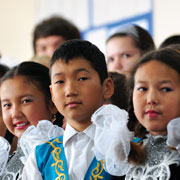Human capital
Box 4.1 - Estimating returns to tertiary schooling
- Details
- Human capital
Investigating the determinants of returns to tertiary schooling, as summarised in Table 4.2, is a two-stage process. The first involves estimating returns at the country level. The following equation is estimated for each country using the pooled sample of wage-earning heads of households in the first and second LiTS surveys:1

where i and c denote household i in country c and yi,c denotes the household’s subjective income ladder position, measured on a scale of 1 to 10 (where 10 means that the head of the household considers the household to be in the highest income decile).2PrimEduci,c is an indicator that takes the value 1 if the head of the household has completed only primary education and 0 otherwise, TertEduci,c is a similar indicator for tertiary education, and Experiencei,c denotes the work experience of the head of household i in country c, which is assumed to be equal to the length of the individual’s post-school life.3Wavei,c indicates the LiTS survey round to which the data correspond. βTertEduc,c is the coefficient of interest, capturing the added value of attaining a tertiary degree compared with completing only secondary schooling in country c.
It is important to point out two potential limitations of this regression.
- A crucial assumption is that the experience and educational achievements of the head of the household contribute to his or her perception of the subjective income of the entire household. Since that income may also reflect the spouse’s income, for example, or other sources of income, this may not always hold.
- The subjective income position may not be a reliable predictor of objective economic outcomes.4 As a result, it is important to consider the true nature of the subjective variable when interpreting the results.
In the second stage, the estimated country-level returns to tertiary education (βTertEduc,c) are regressed on supply and demand factors, as well as institutional environment variables, as follows:

where Supplyc and Demandc represent country-specific factors (or proxies for such factors) affecting the supply and demand channels in country c, as described in the main text.5InstEnvirc denotes a particular aspect of the institutional environment. Table 4.1.1 shows that the institutional variables used in the analysis are highly correlated with each other.6 For this reason, only one is included at any given time (see Table 4.2).
- This follows the standard “Mincerian” regression approach to estimate the determinants of wages or earnings. The LiTS survey is split into two parts, with two possible respondents. The first respondent is the head of the household or a knowledgeable family member, while the second is selected randomly from among the members of the household using the Kish grid method (a pre-assigned table of random numbers). The subjective income variable and the education level variable are included in the second part of the survey, where the respondent is chosen at random. [back]
- The exact wording is as follows: “Please imagine a ten-step ladder where on the bottom, the first step, stand the poorest people and on the highest step, the tenth, stand the richest. On which step of the ten is your household today?" [back]
- Specifically, Experiencei,c = agei - 6 -YrsEduci, where YrsEduc is six years of schooling for primary education, 12 years for secondary education and 16 years for tertiary education. [back]
- See Cojocaru and Diagne (2013). [back]
- The percentage of the population aged 25 and over who had completed tertiary education in 2005 (which is the year closest to the base year) was calculated on the basis of the widely used Barro-Lee dataset, augmented with additional census-based and survey-based data used to impute figures for the missing countries. For the countries missing from the Barro-Lee dataset, the percentage of people having completed tertiary education in 2005 was imputed using census data, IIASA/VID imputations and data from the UNESCO Global Education Digest (GED; 2008 and 2011). Where data for people over the age of 25 were not available, data for people over the age of 15 were linearly interpolated using the assumption that the percentage of people between the ages of 15 and 24 who have completed tertiary education is equal to the percentage of all people over the age of 15 who have such an educational level. In Kosovo there were no census data available prior to 2011, so the Demographic and Health Survey from 2003 was used for the purposes of interpolation. Further adjustments were made to reflect the fact that unlike the Barro-Lee dataset, the IIASA/VID and GED datasets include non-university education in the tertiary category. [back]
- To improve the comparability of the institutional factors, all of the institutional indices were adjusted to fit a scale between 0 and 10. [back]













